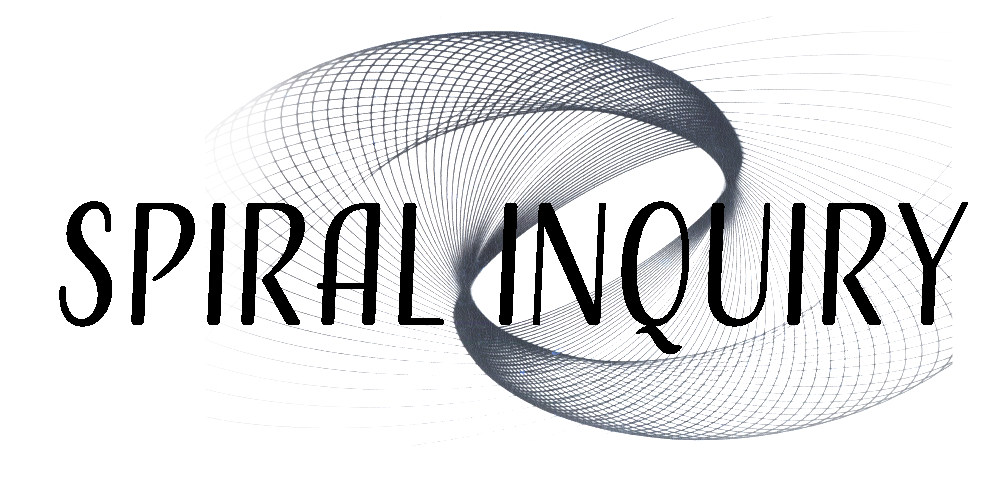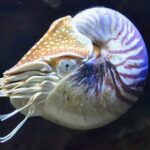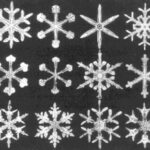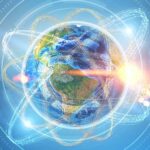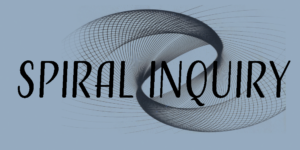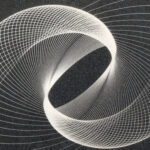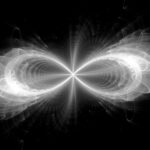My presentation to the SSE on Emergence and Intention has been released on video. The presentation is based on my Essay The How and the Why of Emergence and Intention ((see: Spiral Inquiry post), and it offers a rebuttal of the multiverse theory and explains how the universe is fundamentally beneficent in its nature and evolution. The Society for Scientific Exploration (SSE), founded in 1982, serves as a forum for sharing original research on cross-cutting and unconventional scientific topics. The presentation was given at their 2017 annual conference, held at Yale University. (see: my summary)
The following is the written presentation notes and slides. It may help to read along as you listen to the presentation. The original paper on which it is based is available on the publication page.
Slide 1 – Good afternoon, and thank you.
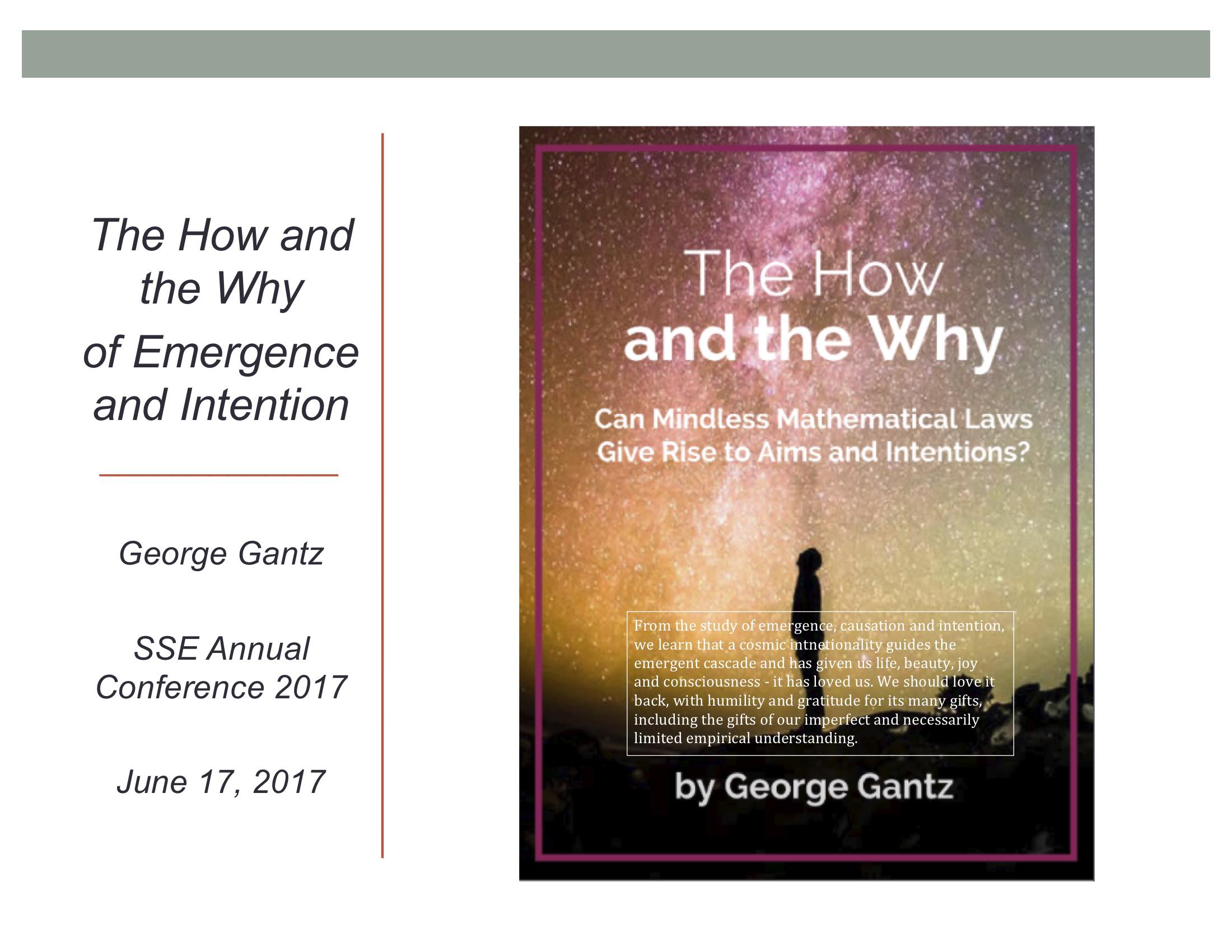
> I am going to cover ideas that were included in my 2017 FQXi essay – “The How and the Why of Emergence and Intention”. The topic for the essay contest was – “Wandering Towards a Goal – How can mindless mathematical laws give rise to aims and intentions.”
> FQXi is The Foundational Questions Institute (FQXi), founded in 2005 to address questions at the foundations of physics and cosmology. Elite membership of about 300 – Max Tegmark is Scientific Director; Advisory Board members include David Chalmers, Alan Guth, Martin Rees, Lee Smolin, and Frank Wilczek. Just to be clear – I do not have the qualifications to be a member, but anyone can participate in the annual essay contests.
>There were 229 essays submitted this year – after the community ranking process where essayists comment, critique and rate each other, I am pleased to say mine was in 5th place – the top 30 now go to an outside panel of experts for final awards later this summer.
>We have a lot to cover but hopefully we can get through the major points and have time for some questions.
>We are going to start with something fun, what I call the Typing Monkey Theorem.
Slide 2
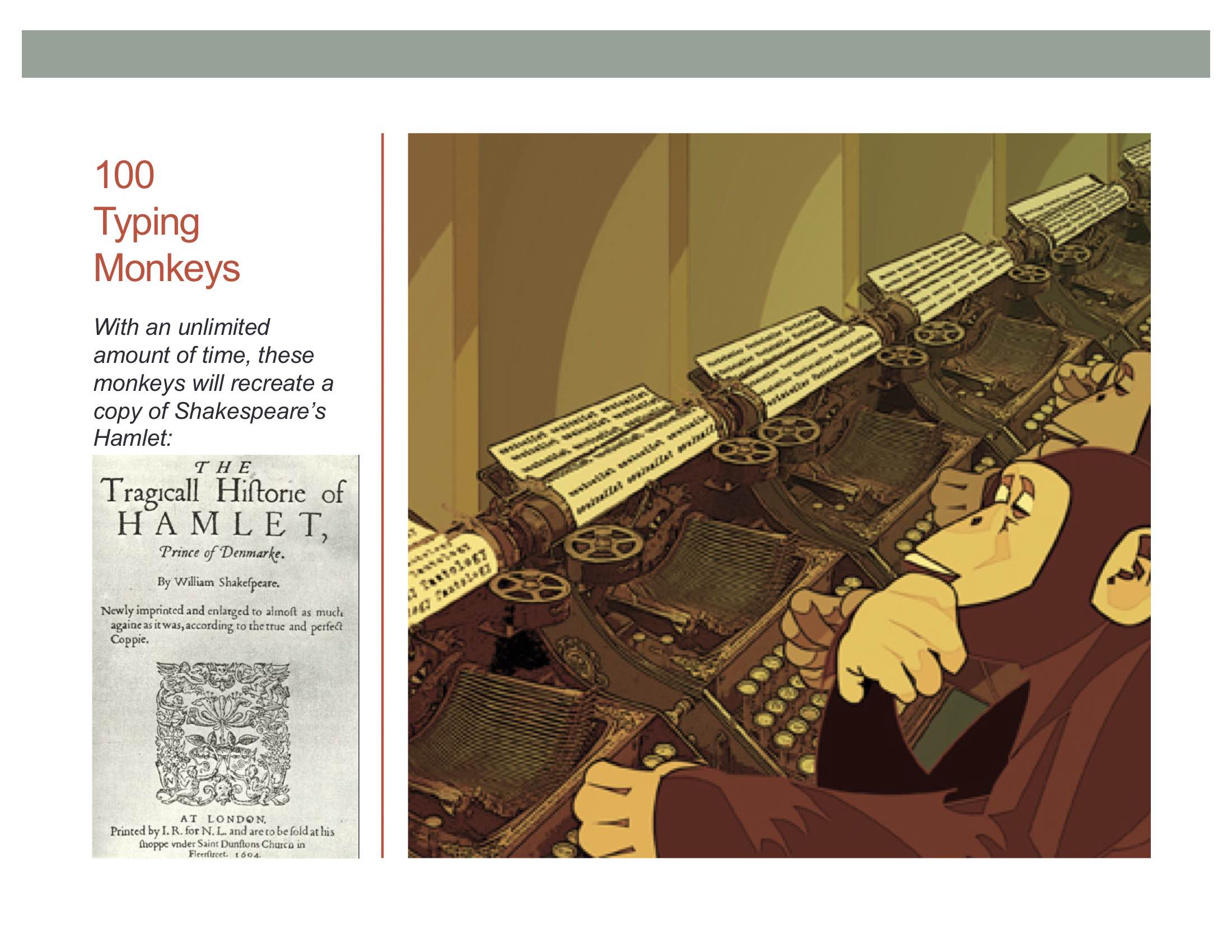
>Here we have a team of monkeys typing away – presumably randomly – for an unlimited period of time. Eventually, somewhere in the reams of nonsense, the monkeys will produce a complete copy of Shakespeare’s Hamlet. That may take a long time, but that’s one of the nice features of infinity – a lot can and eventually will happen.
> May be tricky to find that copy of Hamlet, but let’s assume someone is lucky enough, or has a powerful enough computer with algorithms that can filter through the nonsense and pick out the gem and print a copy.
>Now let’s consider a different scenario – you find a manuscript you identify as a copy of Hamlet. Let’s be logical. What are the options here?
Slide 3 This could be a work of genius
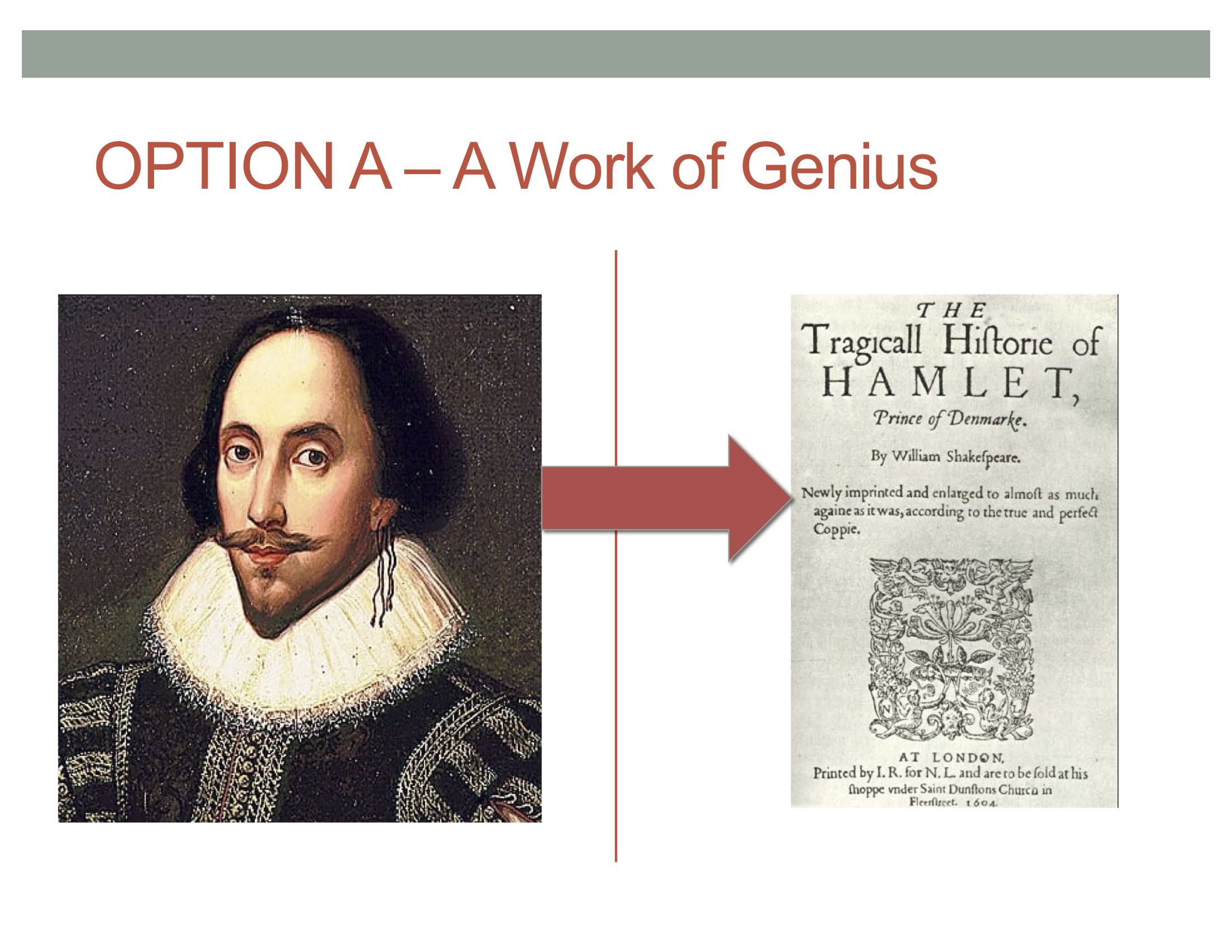
Slide 4 or could be produced by a team of typing monkeys
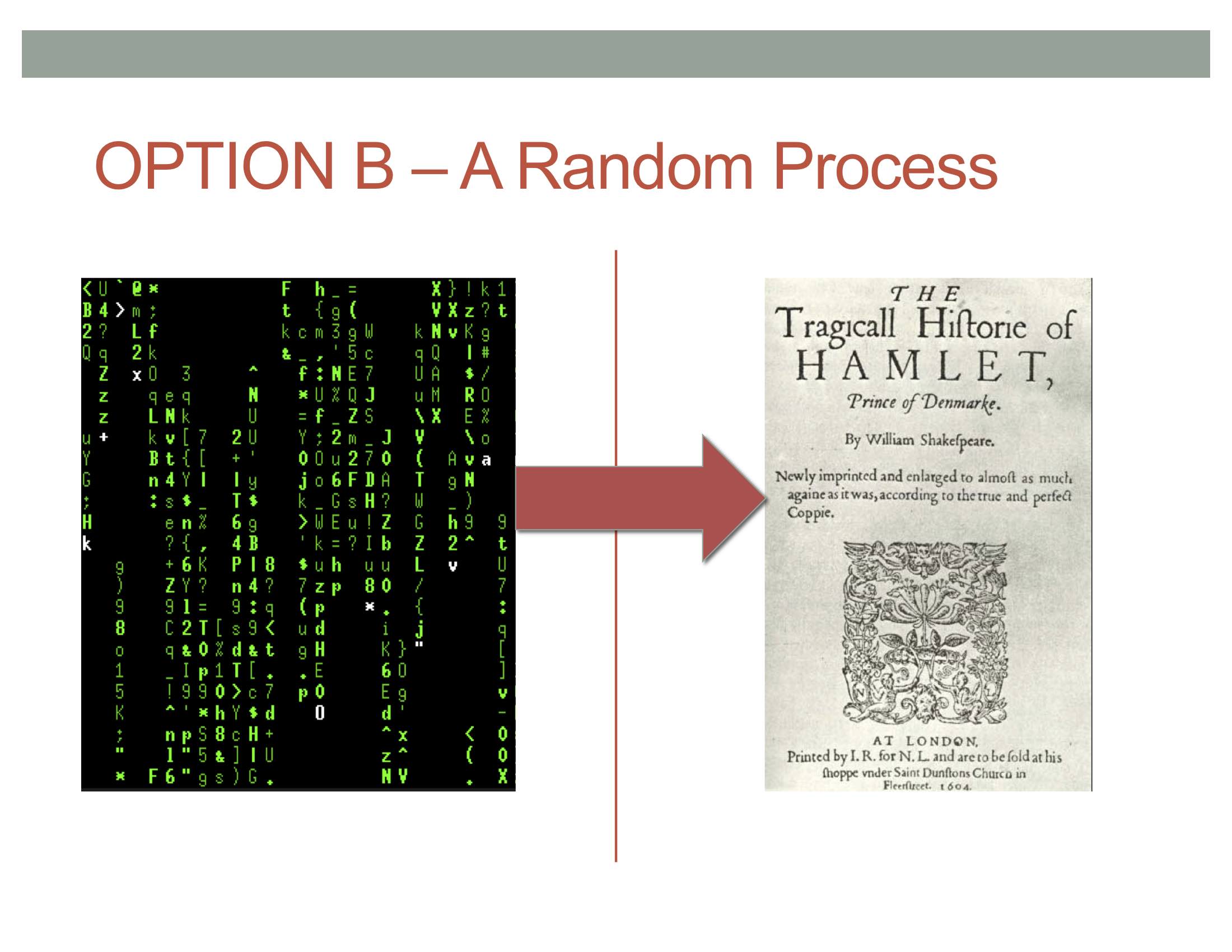
Slide 5 – Here is your challenge. The manuscript is in front of you. Is this the real work of genius? Or is this the filtered output from a team of typing monkeys?
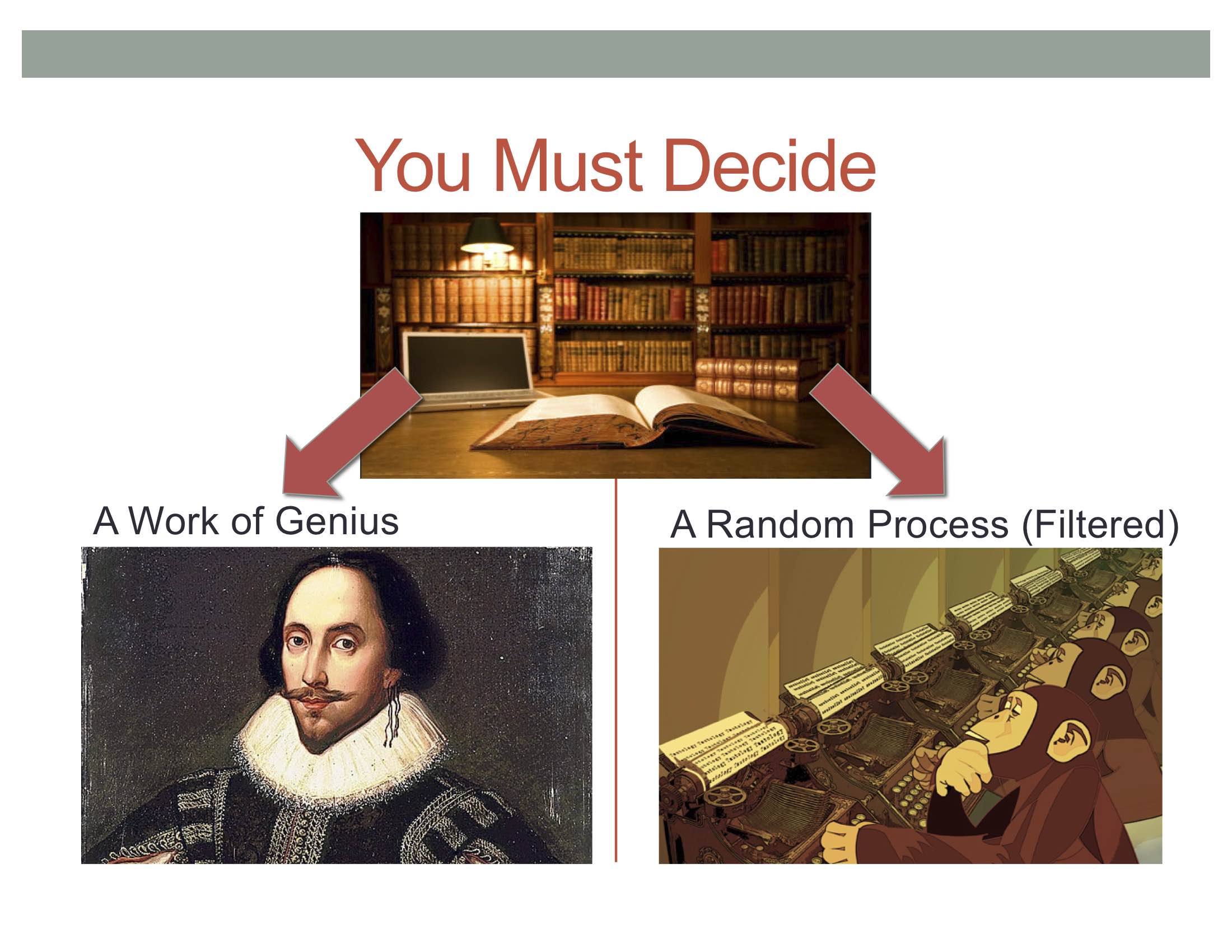
Slide 6 – Logically, the question is undecidable.
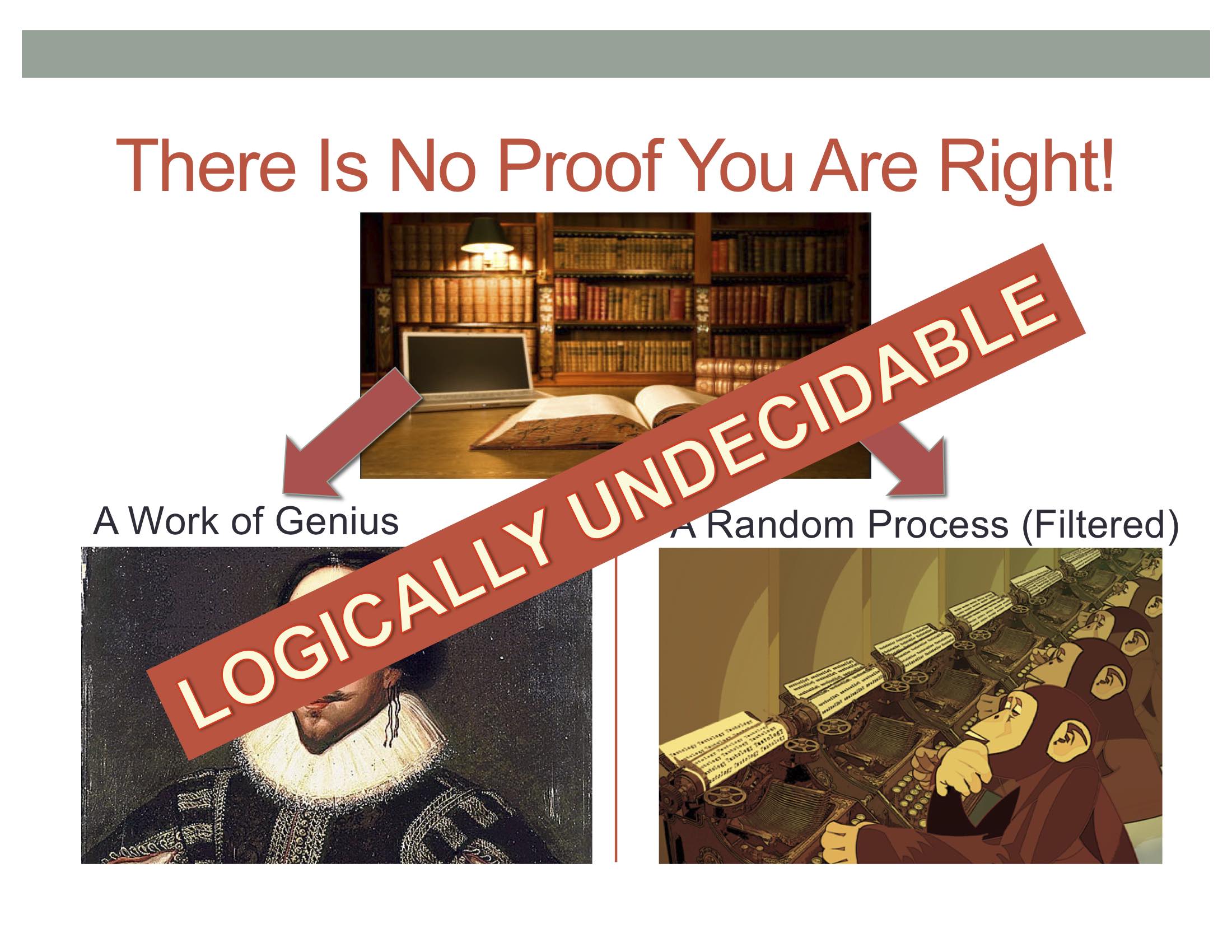
>There is no proof that one choice or the other is correct, based on the information you have. But how many vote for the work of Shakespeare? The alternative seems pretty unlikely doesn’t it?
>This example demonstrates a difficulty for how we evaluate empirical evidence, particularly in dealing with very large (or potentially infinite) data sets. As you explore such a data set, you might actually find the equivalent of a copy of Shakespeare’s Hamlet – but is it meaningful?
>Let’s take a look at a different topic – quantum physics.
Slide 7 – QP has been around for 100 years, and it has been the source of considerable confusion. Here are some examples: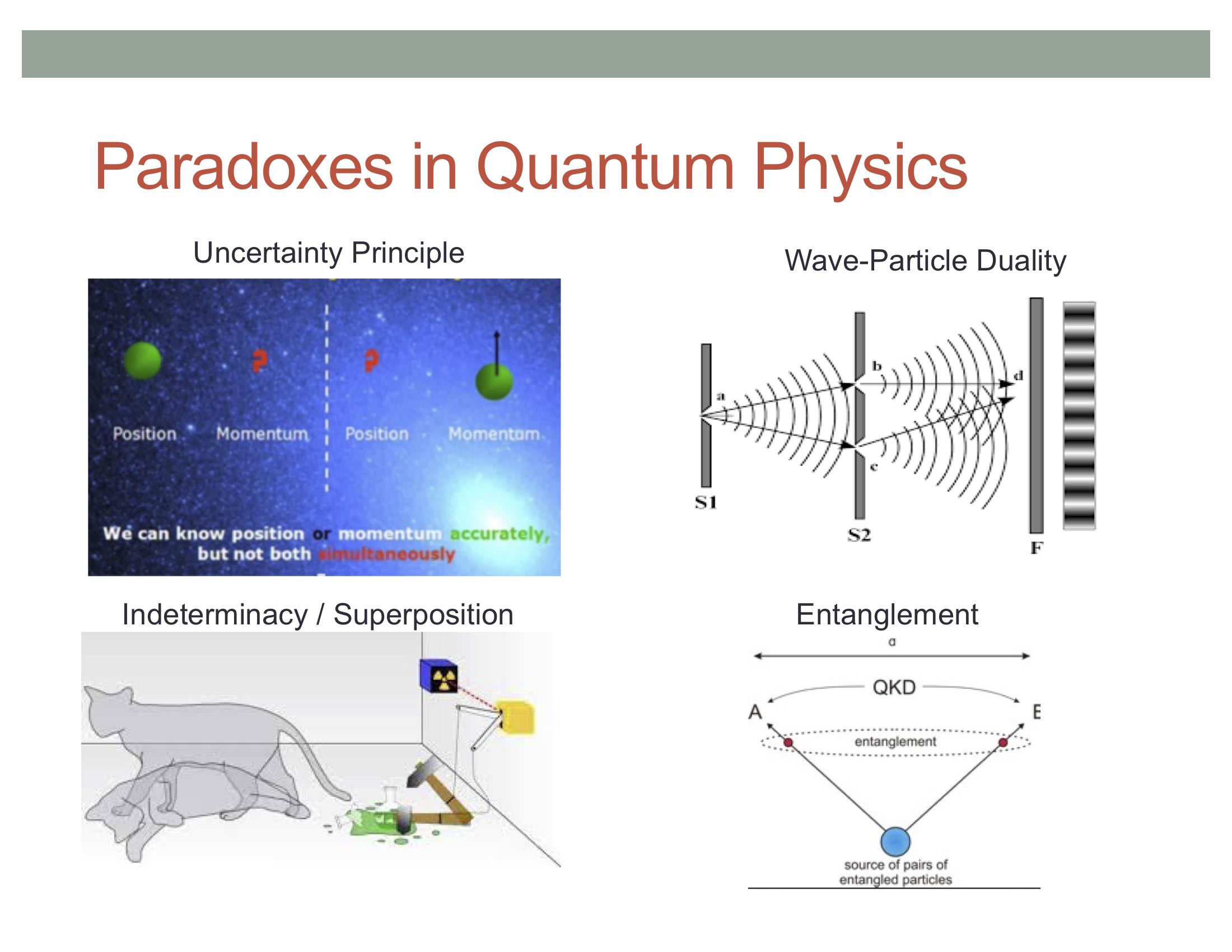
>The Uncertainty Principle – we can measure the position of a particle, or its momentum, but not both? Why? Because the measurement of position changes the momentum, and vice versa.
>Wave-Particle Duality – This is a picture of the double-slit experiment, which showed that even when light particles are fired at two slits, the pattern that appears on the photographic plate demonstrates interference – but interference is a property of waves, not particles
>Then we have indeterminacy and waveform superposition. The picture here is of the thought experiment known as Schrodinger’s Cat. There is a radioactive particle that will decay at some point. When it does decay, it triggers a switch that drops the hammer, which cracks the poison vial, and then the cat dies. Before an observation is made we don’t know if the particle has decayed and killed the cat or not – it has a probability distribution over time. QP says that as long as we do not open the box, both possibilities are in a superposition – a waveform superposition – and when the box is open and the observation made, the waveform collapses into one or the other possibilities – but before the observation is made both possibilities are somehow real – and the cat is both dead and alive.
>Finally, we have the example of entanglement – when two identical or paired particles are created in a reaction and fly off in different directions. Prior to measurement, there is some probability the charge, for example, is positive, and some probability it is negative. If the charge of one of the particles is measured as positive, then the other will be negative too — no matter how far away that particle is. This phenomenon is what Albert Einstein called “spooky action at a distance.”
Slide 8 – 100 years – no resolution – not much progress

>The image on the left side is the cover of Lee Smolin’s book The Trouble With Physics – the shoelaces are tied together in strings – string theory has been the leading contender for a way to unify the contradictions of quantum and classical physics. String Theory has been with us for 50 years with little to show – in some versions the strings became branes (as in membranes of two dimensions or more) – including one model creatively called P-branes – ultimately we had Hawking’s M-Theory, which postulated that all these theories were variations on the same explanations. Ultimately little progress – many have given up. Even Hawking gave up on TOE… there is “no theory-independent reality”.
>On the right – depiction of particle interactions but I’m using it as an illustration of a seemingly simple problem – the fine-tuning of the fundamental physical constants. 25 dimensionless units required by the standard model of particle physics to describe the universe we live in. These constants determine things like the force of gravity or the mass of all the particles… They are all extremely precise – and if they were minutely different, the physics of this universe would be very different, the chemistry as we know it would not exist, and life would not be possible. This remarkable fine-tuning has no apparent pattern – physics and cosmologists have no explanation. This is awkward to say the least!
Slide 9 – but they have thought about it.

>The leading hypothesis to resolve some of these paradoxes is the multiverse. In varying formulations it answers three different problems. – Waveform collapse – Fine-tuning – The unreasonable effectiveness of mathematics.
>How does this work? Very simply – at any point where there is a choice, or there appears to be a choice, the universe splits:
>For example, in the case of Waveform collapse – an observer sees a particular outcome, for example a waveform collapse produces a positive charge in this universe, but now there is another universe where the alternative outcome has taken place – the charge is negative.
>In the case of fine-tuning, the multiverse also has a simple answer – any possible configuration of values for the fine tuning constants exists, or did exist, in a universe somewhere.
>Similarly in the case of mathematics, across the entire range of possible mathematical forms and relationships, there is a universe somewhere for each of them.
>What do all these imaginative leaps achieve? They preserve the idea that the universe is random, and protect us from the implication that the outcomes al each and every point of divergence were chosen – carefully selected from among the possibilities.
Slide 10 – This book was written by Max Tegmark – I refer to this idea as Random Cosmology – he describes the multiverse across 4 levels. I II III IV
 >This cosmology preserves the belief that the universe is fundamentally random and has not been subject to some unknown and invisible selection process. It is a reasonable hypothesis – just consider one alternative idea – that quantum particles, in the case of waveform collapse, are making a choice? Does that mean they have free will? This theory has been floated – it is a pretty hard pill for many to swallow.
>This cosmology preserves the belief that the universe is fundamentally random and has not been subject to some unknown and invisible selection process. It is a reasonable hypothesis – just consider one alternative idea – that quantum particles, in the case of waveform collapse, are making a choice? Does that mean they have free will? This theory has been floated – it is a pretty hard pill for many to swallow.
>The alternative to the infinite multiverse appears to be a conclusion that we live in a precisely chosen universe – fine tuning constants, waveform collapse and all.
Slide 11 – OK. We are back in that room, trying to make a choice. What is our universe like? We in one room – one universe – one perspective. But it has been speculated that reality is an infinite multiverse.

Slide 12 – OK, quick – what do you choose –

>Is our universe a work of genius or the outcome of a random process (carefully filtered – since we happen to be in this one)?
Slide 13 – The choice is logically undecideable – there is no proof one way or the other. So, let’s take a look at some evidence.

Slide 14 – I’m going to talk now about complexity theory – the theory of nonlinear dynamics systems – what is commonly called emergence.

> The evidence is that there is a consistent increase in the complexity of structures at the system level in all fields – physics, chemistry, and biology. On the surface this appears to violate the laws of physics, specifically the 2nd Law of Thermodynamics. According to the second law, everything is progressing inexorably from low entropy states to higher entropy states through time. Entropy is increasing, which means everything becomes more homogeneous – more mixed
> But what we see in dynamics systems are local violations of the 2nd law – we now know that structure and order emerges by exporting entropy to the larger system.
>Stars do not scatter across the heavens – they clump and cluster, and most of the time they begin to spin is spirals. Profound structures – created by exporting entropy, or in other words, dissipating energy, to the larger environment.
>Or look at the crystal structure of snowflakes – created in the turbulence of clouds when conditions are right. Amazingly varied, orderly structures – hardly the mixed up homogeneity the second law would predict.
>We have orderly patterns of waves, tides, swirls and eddies emerging from the complex interaction in flowing water.
>A flock of birds, demonstrating sophisticated swirling patterns in what is known as a murmuration.
>And the seeds of the sunflower, pushing against each other as they grow – yielding interlocking spirals spinning right and left.
>Structure, complexity, beauty, and intelligence, emerging in response to the pull of entropy.
>Where does this come from? What brings this about?
Slide 15 – Let me talk about the concept of Intentionality. Everything is in motion – everything has a direction. I refer to this feature as intentionality. Now this is not the same as conscious intention – this kind of intentionality is simply the momentum, direction, purpose or disposition that we observe.
 >The billiard ball has direction and momentum – it is going to interact in a specific way when it strikes another billiard ball. It has intention. Similarly, the cue that struck the billiard ball had motion, direction, speed and power – it has intention. And we can see hands holding the cue stick – they also exhibited intention in moving the cue stick in a certain way. Behind the hands, perhaps a human, making calculations, and proceeding with conscious intention. Although perhaps the cue strike was inadvertent – or the human actually a robot. We can observe the intention – but we do not know the interior state and whether the entity is a conscious agent or not.
>The billiard ball has direction and momentum – it is going to interact in a specific way when it strikes another billiard ball. It has intention. Similarly, the cue that struck the billiard ball had motion, direction, speed and power – it has intention. And we can see hands holding the cue stick – they also exhibited intention in moving the cue stick in a certain way. Behind the hands, perhaps a human, making calculations, and proceeding with conscious intention. Although perhaps the cue strike was inadvertent – or the human actually a robot. We can observe the intention – but we do not know the interior state and whether the entity is a conscious agent or not.
>Other examples – ants are drive by instinct – they have a purpose – to follow their instinctive foraging pattern, and respond to other ants. That is intention.
>Electrons have intention and the probability distributions they follow result in precise configurations shown in x-ray images.
>Termite mounds: we observe complex structures with specific design features – we observe intention.
Slide 16 – we observe intentionality at all levels and in all systems. What are some of the characteristics of this intentionality?

Slide 17 – the first is Attraction

>As mathematicians studied complex systems, they noticed that the solutions tended to settle in on particular configurations – what they call “attractor states”. The emerging dynamic system is attracted to specific configurations. The graph shows simple convergence – straight, spiral, and convergence to a range of solutions across a line.
>The figure on the bottom is known as the Lorentz attractor – discovered in one of the earliest efforts to model meteorological systems. It showed both a specific pattern of outcomes along a 3-dimensional spiraling plot – but also highlighted the problem of initial conditions. Very minor changes in initial conditions resulted in vastly divergent, unpredictable system configurations. This is known as the butterfly effect – that is what the 2-D representation of the Lorentz attractor looks like. The more fanciful description is that the flap of a butterfly’s wings can alter the course of a storm 1000 miles away.
>Natural systems also demonstrate attraction to specific structure: This is a field of termite mounds – the species is known as the cathedral termite for obvious reasons. There are no architects – no engineers – just a colony of termites and their emergent intelligent behavior.
>In the field of evolution, new findings about convergent evolution demonstrate that identical physiological structures (like wings, ears, eyes) can emerge independently on multiple alternate evolutionary pathways – a kind of attraction to ideal forms.
Slide 18 – so, attraction occurs at all levels in all systems

Slide 19 – another feature of intentionality is cooperation

>Chemistry is the science of molecular cooperation – bonding, unbonding, catalyzing – the cataloguing of relationships and behaviors among molecules of various types in various conditions
>ecology is the science of cooperation and interaction of species in specific environments – plants and animals adapting to and cooperating in response to the geological and meteorological conditions. Yes, there is competition – but in an ecological sense that competition is a search for efficient adaptive solutions – leading to a dissipation of conflict and a maximization in the utilization of the available resources through cooperation.
>Another example – water molecules, learn to cooperate with each other in a fluid environment as they are pulled toward the drain – the efficient structure of a swirling vortex emerges.
>Finally – an image from the LHC at CERN – cooperation among thousands of scientists and billions of taxpayers in support of theoretical physics, producing a structure of unimaginable complexity and sophistication.
Slide 20 – cooperation exhibited at all levels

Slide 22 – Finally, another key characteristic of intentionality is Reciprocity
 >At the component level – reciprocity between the individual component entities – here we see ants – they communicate, they interact – they work together in reciprocal relationships.
>At the component level – reciprocity between the individual component entities – here we see ants – they communicate, they interact – they work together in reciprocal relationships.
>We see reciprocity in the unit-system relationships – the termites work together in a colony and produce a mound – the termite mound provides sophisticated functions that support and protect the termites and lead to their procreation and survival.
>We see reciprocity in relationships at the system level – systems of entities in cooperation – which leads to emergence at the next higher level of organization. Cells to organisms – organisms to species – species to ecologies. A cascade of emergent systems.
Slide 23 – this reciprocity is a key feature of the universal emergent cascade – from physics to chemistry to biology to human systems and civilization. Units comprise systems; systems become units in the next higher level of emergence. From a QP perspective – the waveform only collapses when observed – so here we are with conscious, sentient human beings as observers of the universe, potentially closing the loop with the most rudimentary components of the universe by inducing waveform collapse.

Slide 24 – when we look, we see reciprocity operating at all levels

Slide 25 – So – when we talk about relationships that are intentional, and that exhibit the characteristics of attraction, cooperation and reciprocity —what are we talking about?

Slide 26 – Love. So my conclusion: …

>For the past year and a half I have been studying with a guru – I’d like to introduce him to you.
Slide 26 – – this is Henry – he knows how to explore and love the universe – and it is loving him back.

